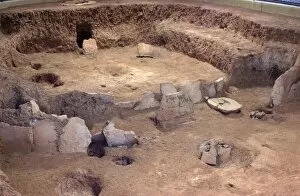8th Century Collection (page 36)
The 8th century was a time of great artistic and cultural achievements, as seen in the intricate illustrations found in the Book of Kells and Lindisfarne Gospels
All Professionally Made to Order for Quick Shipping
The 8th century was a time of great artistic and cultural achievements, as seen in the intricate illustrations found in the Book of Kells and Lindisfarne Gospels. These masterpieces showcase the skill and dedication of medieval scribes who meticulously crafted each page with vibrant colors and detailed designs. In the Arab empire, during the mid-700s, a flourishing civilization emerged, leaving behind magnificent illuminated texts like the Gospel of St Luke. The delicate brushstrokes and gold leaf accents bring to life sacred scriptures for all to admire. As snow gently falls on the small red pagoda at Kiyomizu-dera Temple, a UNESCO World Heritage Site, one can't help but be captivated by its serene beauty. This image reminds us that even in ancient times, architectural wonders were created with precision and grace. A map dating back to c1060 centers around Jerusalem, providing insight into how people perceived their world centuries ago. Crafted by Spanish manuscript illuminators under Beatus' guidance, this map showcases their knowledge and imagination. Historical events are also depicted through artistry; such as Pope Adrian I's meeting with Charlemagne captured in a miniature from Chronicles incunabula. These visual records allow us to glimpse into significant moments that shaped history. The opening words of St Luke's Gospel "Quoniam" from the Book of Kells (c800) demonstrate not only religious devotion but also exquisite calligraphy skills passed down through generations. Each stroke is carefully executed with reverence for these holy texts. Traveling across continents brings us to Tikal: Mayan Inscription where an intricately carved canoe scene adorns an animal bone burial artifact. This testament to Mayan culture reveals their connection with nature and waterways as essential elements in their lives. Moving forward in time to c1960s Japan captures an enchanting photograph showcasing Kongo Rikishi (guardian) within the Todai-ji Temple at Nara.























